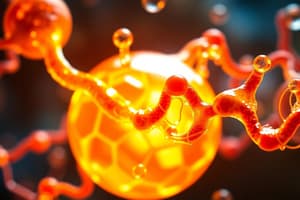Podcast
Questions and Answers
What is an example of an anabolic process?
What is an example of an anabolic process?
- Photosynthesis (correct)
- Digestion
- Fermentation
- Respiration
What defines activation energy in a chemical reaction?
What defines activation energy in a chemical reaction?
- The energy required to break down products
- The minimum amount of energy to start a reaction (correct)
- The total energy involved in a reaction
- The energy released after the reaction
Which statement describes catabolism?
Which statement describes catabolism?
- Large molecules are broken down into smaller molecules (correct)
- Small molecules are combined to form larger molecules
- It only occurs in plants during sunlight
- Energy is primarily stored in the form of ATP
How do enzymes contribute to chemical reactions?
How do enzymes contribute to chemical reactions?
What is one way enzymes lower activation energy?
What is one way enzymes lower activation energy?
What is a characteristic of enzymes regarding their composition?
What is a characteristic of enzymes regarding their composition?
How do enzymes typically behave after a chemical reaction?
How do enzymes typically behave after a chemical reaction?
What role do enzymes play in chemical reactions?
What role do enzymes play in chemical reactions?
Which of the following statements about enzyme synthesis is true?
Which of the following statements about enzyme synthesis is true?
What is a possible effect on enzymes caused by changes in environmental conditions?
What is a possible effect on enzymes caused by changes in environmental conditions?
What is the function of the active site in an enzyme?
What is the function of the active site in an enzyme?
Which type of cofactor is covalently bonded to an enzyme?
Which type of cofactor is covalently bonded to an enzyme?
What characterizes co-enzymes?
What characterizes co-enzymes?
Which of the following is NOT a type of cofactor?
Which of the following is NOT a type of cofactor?
Which statement best describes intracellular enzymes?
Which statement best describes intracellular enzymes?
What is the minimum amount of energy required to start a reaction called?
What is the minimum amount of energy required to start a reaction called?
Which of the following represents how enzymes lower activation energy?
Which of the following represents how enzymes lower activation energy?
What is one effect of an enzyme on the activation energy curve compared to a reaction without an enzyme?
What is one effect of an enzyme on the activation energy curve compared to a reaction without an enzyme?
Which of the following is NOT a way enzymes lower activation energy?
Which of the following is NOT a way enzymes lower activation energy?
In the graph depicting activation energy with and without an enzyme, what do the axes represent?
In the graph depicting activation energy with and without an enzyme, what do the axes represent?
Flashcards are hidden until you start studying
Study Notes
Activation Energy (Ea)
- Defined as the minimum energy required to initiate a chemical reaction.
- Energy is consumed to break bonds in reactants to transform them into products.
How Enzymes Lower Activation Energy
- Enzymes alter the shape of the substrate, facilitating reaction.
- Disruption of charge distribution on substrates aids in decreasing activation energy.
- Graphical representation shows:
- Higher activation energy without enzymes leads to less energy released during the reaction.
- Lower activation energy with enzymes results in greater energy release.
Metabolic Processes
- Anabolism: Constructive process combining small molecules into larger ones (e.g., photosynthesis).
- Reaction example: CO₂ + H₂O → C₆H₁₂O₆ + O₂ + H₂O
- Catabolism: Destructive process breaking down large molecules into smaller ones (e.g., respiration).
- Reaction example: C₆H₁₂O₆ + O₂ → CO₂ + H₂O + ATP
Characteristics of Enzymes
- Proteinous Nature: Enzymes are made of proteins.
- Unchanged After Reaction: Enzymes do not get consumed in the reaction process.
- Specific Functionality: Each enzyme catalyzes a specific reaction.
- Minimal Usage: Required in very small quantities relative to the substrate.
- Accelerate Reactions: Enzymes can significantly speed up reaction rates.
- Lower Activation Energy: Enzymes effectively reduce the energy needed for reactions.
- Sensitivity: Enzymes are sensitive to variations in temperature, pH, and substrate concentration.
- Synthesis Location: All enzymes are synthesized within cells.
- Extracellular Enzymes: Work outside cells (e.g., pepsin in the stomach).
- Intracellular Enzymes: Function within cells (e.g., mitochondrial enzymes).
Active Site
- Specific region on an enzyme where substrates bind to initiate the reaction.
Need for Cofactors
- Non-protein components necessary for enzyme function.
Types of Cofactors
- Prosthetic Group: Non-protein organic molecules covalently bonded to enzymes (e.g., heme in hemoglobin).
- Co-Enzymes: Organic molecules loosely attached to enzymes, essential for activity (e.g., NAD, FAD).
- Activators: Inorganic ions that serve as cofactors (e.g., metal ions like Mg, Fe, K).
Enzyme Specificity
- Each enzyme is dedicated to a specific substrate, reflecting its unique functional role in biochemical reactions.
Studying That Suits You
Use AI to generate personalized quizzes and flashcards to suit your learning preferences.




